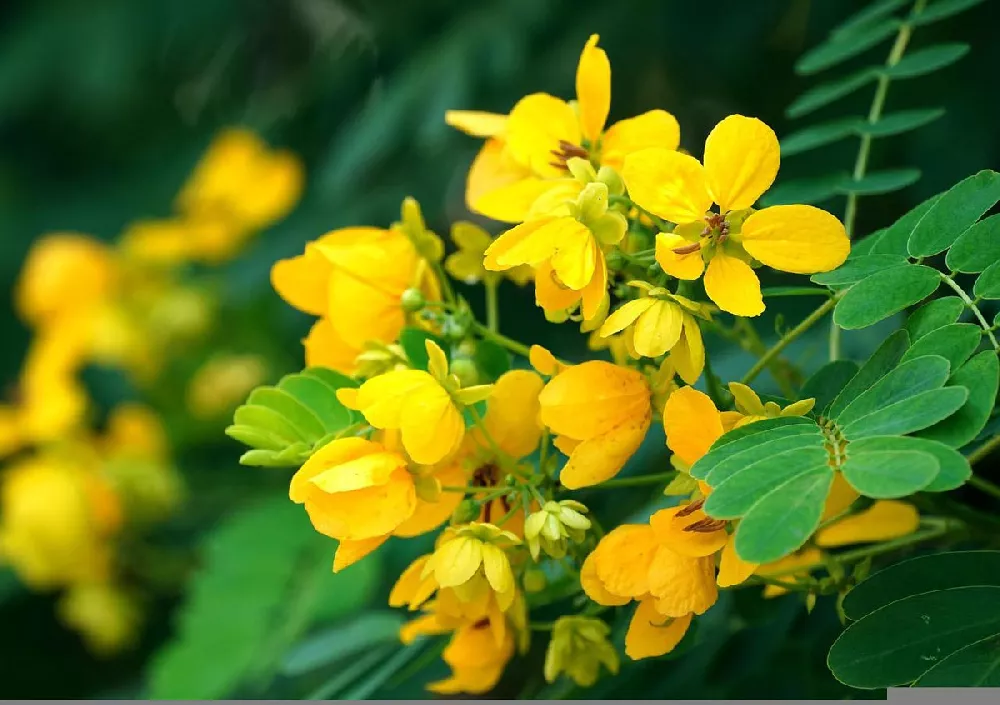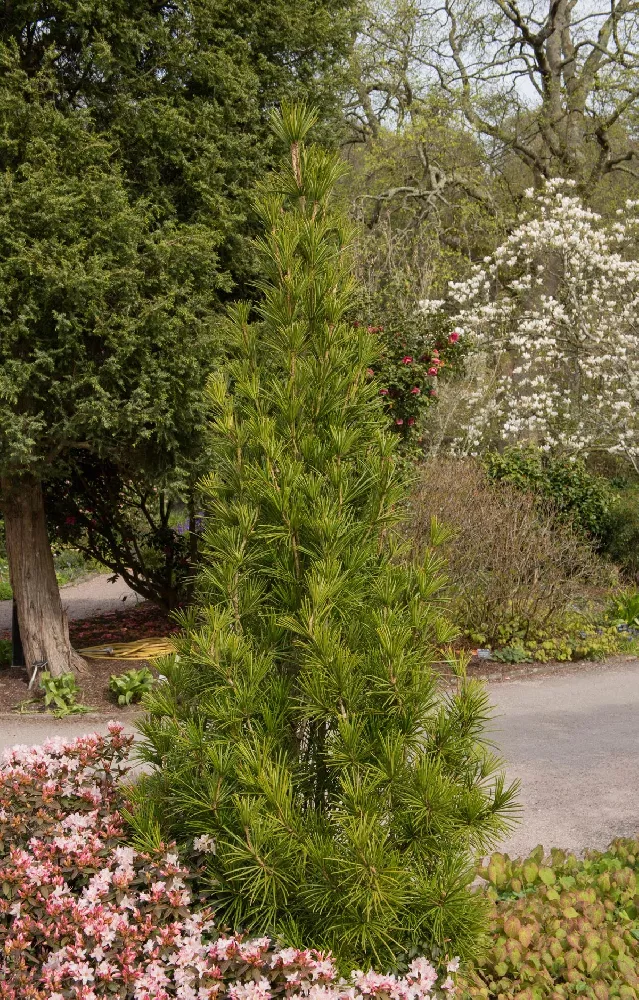Dark Blue Plumbago for Sale - Buying & Growing Guide
Plumbago auriculata ‘Dark Blue,’ is a versatile, showy plant in the garden landscape. It is equally attractive as a shrub when mounding on the ground as when planted in a container, or climbing a trellis. Its dark green evergreen foliage is offset by stunning blue flowers that bloom from early spring to late fall. A low maintenance, high-reward choice that can live for 40 years or more, here are some other desirable traits of the ‘Dark Blue’ Plumbago Plant:
- It has two-inch green leaves and masses of attractive, five-petaled blue flowers, which bloom year-round in warm climates.
- It makes an excellent ground cover plant and can grow as a climber up a trellis.
- Does best in high humidity environments.
Enter your zip code to find nearby stores that may carry this plant.
Plant Care
Sunlight

Although plumbago tolerates partial shade, it will flower more profusely in 6 or more hours of full sun per day.
Watering
When newly planted, water several times a week. Once established, it is fairly drought-resistant.
Fertilizing

Fertilize during the growing season with a balanced product formulated for blooming plants.
Planting and Care
Planting instructions
The ‘Dark Blue’ Plumbago Plant is native to the sunny, hot, humid climate of South Africa. It thrives in similar conditions outside of South Africa such as those found in zones 8 through 11 in the US. It also grows in other areas if given appropriate care. If you live in a climate where winter temperatures drop below 32 degrees Fahrenheit, bring this plant inside to winter in a garage, sheltered from freezing temperatures. If kept outdoors, cut back to ground level and protect with a heavy layer of mulch. Alternatively, treat it as an annual.
‘Dark Blue’ Plumbago Plants like to spread, so give them plenty of room in a sunny spot with some afternoon shade in your garden. This plant thrives in well-draining soil and will either spread out as a foundation plant or climb up a trellis if trained.
Also a popular container plant, ‘Dark Blue’ Plumbago can be trained to almost any shape, including as a shrub, a climber, or cascading out of a hanging basket. Because of its rapid growth, ‘Dark Blue’ Plumbago Plants should be repotted every two to three years, so they don’t become rootbound. You can easily bring them indoors to winter-over — just place plants in containers in a sunroom or a spot by a sunny window. If placed in a dark, cool spot indoors in winter, ‘Dark Blue’ Plumbago will go dormant until the spring.
Watering and nutrients
‘Dark Blue’ Plumbago Plants should be kept consistently moist when first planted and throughout the first growing season, but once it’s well established it will tolerate drought. This is less true for container plants, which are susceptible to root rot, and as a result, should be given moderate amounts of water. Plants that are brought in during the winter will need less water, and watering can be skipped altogether if the plant becomes dormant.
Humidity is recommended for an indoor containerized ‘Dark Blue’ Plumbago Plant. A plant grown indoors should be provided with frequent misting and kept away from vents and heaters. Indoor plants in containers may benefit from an electric humidifier.
It’s a good idea to provide your ‘Dark Blue’ Plumbago with a fertilizer that’s high in potassium on a regular basis during the growing season. Doing so ensures that you have a steady flow of blooms. Adding phosphorus to the soil will strengthen the plant’s root system, which is integral to its long-term health.
Pruning
Pruning is essential for keeping ‘Dark Blue’ Plumbago growth controlled. The plant grows rapidly, and can easily reach 10 feet tall and wide if left unattended. One of the benefits of the ‘Dark Blue’ Plumbago is that its shaping is so versatile. The plant can be trained into a hedge shape, as a simple shrub, into ground cover, or as a climber if trained and supported by a trellis. Plants kept in containers require frequent pruning, whether trained upright or as trailing plants.
Pruning during the growing season will encourage more blooms. At the end of the growing season, Blue Plumbagos growing in cooler climates need to be dramatically cut back to a height of no more than two inches from the ground, then covered for frost protection until warmer weather returns. Prune plants in containers to an appropriate size for a sunny spot in the house.
Temperature
The Blue Plumbago Plant was originally discovered in the hot environment of South Africa and has since been introduced to mild climates around the world, including Florida, Texas, California, Australia, and Spain.
If you live in an area which is mild all year round, then this is the ideal growing environment for this plant. In warm temperatures, it is able to flower all year round. It can be grown in slightly cooler climates but will die off over winter and need to be cut right back to ground level, or if kept in a container, it can be brought inside throughout winter to avoid frost. The lowest temperature this plant can tolerate is around 32 degrees Fahrenheit, so make preparations to protect your plant or winter it inside if your local climate typically drops below this over winter. In spring, the Blue Plumbago planted in the ground will usually come back to life and continue with its impressive growth. Container plants can be cut back before being moved back outside in warmer weather to stimulate growth.
Light
As a native of South Africa, this plant is accustomed to a warm and bright climate. If kept outside, it will need to live in a spot with plenty of direct sunlight in order for it to really flourish. It will tolerate growing in shade, but this will come at the expense of flower production. If kept indoors, it will do best in the full sun of a conservatory or sunroom, or on a bright windowsill.
Humidity
This plant loves high humidity and will do very well in climates which have naturally moist air. If you live in a warm and humid environment that enjoys a mild temperature all year round, then this is a great plant to have. It will tolerate moderate humidity though may lack some blooms as a result. Blue Plumbago Plants grown in glasshouses, sunrooms, conservatories, or on bright windowsills, will benefit from frequent water mistings to keep the humidity up. If you have several humidity-loving plants in one room, then an electric humidifier might be useful to consistently keep humidity high without you having to make a continued effort.
Dry air will damage this plant, so if it is kept indoors, be sure to keep it away from heating vents, stoves, or any other items which could dry out the plant.
Fertilizer
Blue Plumbago Plants will benefit from a regular application of fertilizer during growing seasons. A fertilizer high in potassium will result in an abundance of lush flowers, while phosphorus will help the plant to develop a good root system, which is important for its overall growth and long-term health. The type of fertilizer you choose really comes down to personal preference.
If you prefer to feed your plants only occasionally and not have to worry about a frequent feeding schedule, then slow release fertilizer could be the best option for you. There are many types of fertilizer on the market to suit everyone’s budgets and requirements. You can be quite specific about the fertilizer you use on your plant, doing in-depth research to find the ideal proportions of nutrients, or you can buy a general all-purpose fertilizer. Go with whatever works best for your situation; just ensure that you are following the instructions on the bottle and getting your Plumbago the nutrients it needs.
Repotting
If your Blue Plumbago lives in a container, you will need to repot it every two to three years. The plant grows rapidly and can quite quickly fill its pot with roots and become root-bound. In order to allow your plant to stay healthy and continue to grow year after year, repot it when it is struggling for space in its container.
The best time to do this is either at the beginning of spring before you move the Blue Plumbago back outside, or in early autumn when you bring the plant inside to overwinter it. At both of these times, the plant should have been cut back and will be small enough to make handling much easier. To see if your plant requires repotting, firmly hold the base of the plant and gently tug until the root ball and its soil comes loose from the pot. You should quickly be able to see how condensed the roots are and if they need more space. If you are unable to remove the plant from its container with ease, then this is probably because the roots are so tightly packed that they have become jammed in the pot, and is a definite sign that you should repot your plant.
To repot the Blue Plumbago, gently remove it from its current container and rub the roots between your fingers to loosen them and allow any of the old soil to break free and be removed. Remove as much old soil as you can without harming the root structure. Select a new container one or two sizes bigger than the current one and fill the bottom with a well-draining soil, ideally with some sand mixed in to increase drainage efficiency. Place the root ball of your plant on top of the soil, then gently pack more soil in all around the edges. The plant should sit at the same height in the pot as it did in its last pot. Water the plant heavily and then continue care as normal.
Propagation
The Blue Plumbago Plant can be easily propagated using wood cuttings, so if you already have one of these plants, then you could also have an endless supply of new Blue Plumbagos to have in different areas or to gift to friends.
To propagate, you will need around a four or five-inch stem cutting from a woody part of the plant. Cut it from the mother plant using sharp shears at a 45-degree angle, creating more surface area from which roots can grow. Dip the cut end of the stem in rooting hormone to encourage the cutting to develop roots, and plant it into a small pot filled with potting soil. Keep the soil continually moist without allowing it to become wet, and place it in a shaded area. Heating the cutting from underneath will help roots to develop, though it is best to propagate this plant in the summer when temperatures are ordinarily higher.
Within four weeks your cutting should have the early stages of a root system. You will know if roots have developed if you gently tug on the cutting and feel some resistance. If the cutting can be easily pulled from the soil, then it doesn’t yet have roots. Once you have evidence of roots, you can transplant the cutting to a bigger pot and let it grow into a new Blue Plumbago in its own right. When the plant reaches a good size, it can be transferred to a more permanent spot, either directly in the ground or into a container.
Toxicity
All elements of this plant are toxic to humans, including the sap, fruit, pollen, seeds, bark, roots, and foliage. When handling the plant, you should always wear protective gloves and have your arms covered with long-sleeved clothing. Try to keep your face away from the plant and consider wearing protective eyewear. If the toxins come into contact with the skin or eyes, you can expect to suffer from irritation and blistering. It is also harmful if ingested, potentially causing vomiting and an upset stomach.
Interestingly, the plant is not reported to be toxic to animals, so while you might want to keep your distance from the Blue Plumbago, you can allow your pets to roam freely near it. Take particular care to keep this plant away from children.
FAQs
Is ‘Dark Blue’ Plumbago poisonous?
Does ‘Dark Blue’ Plumbago attract butterflies?
‘Dark Blue’ Plumbago is a favorite of birds, bees, and butterflies. It will attract some friendly visitors during the growing season.
Can ‘Dark Blue’ Plumbago be grown from seed?
The plant does produce seeds, but seedlings will not flower until their second year. Seeds may take up to four weeks to germinate and have very specific propagation requirements.











